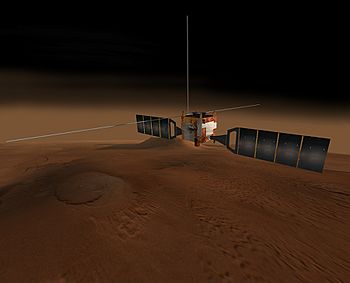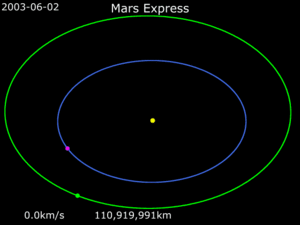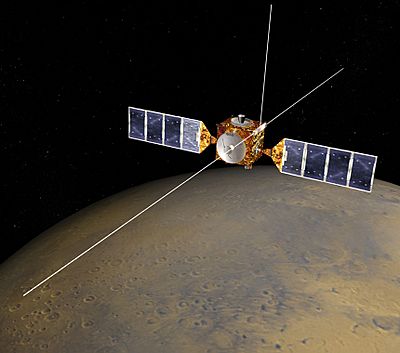Mars Express facts for kids

CG image of Mars Express arriving at Mars.
|
|
| Mission type | Mars orbiter |
|---|---|
| Operator | ESA |
| Mission duration | Elapsed: 22 years, 6 months and 7 days since launch 21 years, 11 months and 14 days at Mars |
| Spacecraft properties | |
| Launch mass | 1,123 kg |
| Dry mass | 666 kg (1,468 lb) |
| Power | 460 watts |
| Start of mission | |
| Launch date | June 2, 2003, 17:45 UTC |
| Rocket | Soyuz-FG/Fregat |
| Launch site | Baikonur 31/6 |
| Contractor | Starsem |
| Orbital parameters | |
| Reference system | Areocentric |
| Eccentricity | 0.571 |
| Periareion | 298 km (185 mi) |
| Apoareion | 10,107 km (6,280 mi) |
| Inclination | 86.3 degrees |
| Period | 7.5 hours |
| Mars orbiter | |
| Spacecraft component | Mars Express |
| Orbital insertion | December 25, 2003, 03:00 UTC MSD 46206 08:27 AMT |
| Mars lander | |
| Spacecraft component | Beagle 2 |
| Landing date | December 25, 2003, 02:54 UTC |
 ESA Solar System insignia for the Mars Express mission |
|
The Mars Express is a space exploration mission led by the European Space Agency (ESA). Its main goal is to explore the planet Mars. This was the first time ESA tried to send a mission to another planet. The name "Express" means that the spacecraft was built very quickly and efficiently. It also refers to its short journey to Mars. This was possible because Earth and Mars were closer than they had been in about 60,000 years when it launched.
Mars Express has two main parts: the Mars Express Orbiter and Beagle 2. Beagle 2 was a lander designed to study if there was life on Mars and what the planet's rocks were made of. Sadly, the lander didn't fully open after it landed. However, the orbiter has been working well since early 2004. It takes high-resolution pictures and maps minerals on the surface. It also uses radar to look under the surface for things like frozen water. The orbiter studies Mars' atmosphere and how it interacts with space.
Because it has been so successful, the Mars Express mission has been extended many times. The latest extension was approved in March 2023. This means it will keep working until at least December 31, 2026, and possibly until December 31, 2028.
Some of the tools on the orbiter, like its cameras and spectrometers, were based on designs from a failed Russian mission called Mars 96 in 1996. European countries had helped a lot with that mission. The overall design of Mars Express is also similar to ESA's Rosetta mission. Using existing designs helped make Mars Express more reliable and cost less money and time to build. This made the total cost of the project about $345 million, which was less than half the cost of similar missions from the U.S.
Mars Express arrived at Mars on December 25, 2003. It is now the second longest-running spacecraft orbiting another planet besides Earth. Only NASA's 2001 Mars Odyssey has been active longer.
Contents
Mission Journey and Key Moments
Mission Goals
The Mars Express mission aims to study Mars from orbit. It also originally planned to study the surface with the Beagle 2 lander. The mission looks at the inside of Mars, its surface, its atmosphere, and the space around it.
A big reason for Mars Express was to complete some of the science goals that were lost when the Russian Mars 96 mission failed. It also added the search for life with Beagle 2. Studying Mars helps us understand Earth better by comparing the two planets.
The spacecraft started with seven science tools, a small lander, a way to relay messages from the lander, and a camera to watch the lander. All these tools were designed to help solve the mystery of Mars' missing water. The main spacecraft is in a polar orbit, which means it can slowly observe the entire planet.
Launch into Space
Mars Express launched on June 2, 2003, from Baikonur Cosmodrome in Kazakhstan. It used a Soyuz-FG/Fregat rocket. First, the spacecraft and its Fregat booster went into a low Earth orbit. Then, the Fregat fired again to send Mars Express on its way to Mars.
The Fregat and Mars Express separated shortly after. The spacecraft then opened its solar panels. A few days later, it made a small course correction to aim perfectly for Mars. This was the first time a Russian-launched probe successfully left Earth's orbit since the Soviet Union ended.
Getting Ready in Space
After separating from the rocket, Mars Express spent about a month getting ready. This included opening its solar panels and getting into the right position. All its instruments were checked one by one to make sure they were working.
Journey to Mars
The journey to Mars took five months. During this time, the spacecraft mostly cruised quietly through space. However, it wasn't always quiet! There were some problems with star trackers and power. The spacecraft also had to make extra course corrections. On October 28, 2003, it was even hit by one of the biggest solar flares ever recorded!
Releasing the Lander
The Beagle 2 lander was released on December 19, 2003. It was sent on a path to land on Mars' surface on December 25. However, scientists could not get in touch with Beagle 2 after it was supposed to land. On February 6, 2004, it was declared lost.
Arriving at Mars
Mars Express reached Mars after traveling 400 million kilometers. On December 25, 2003, the orbiter fired its main engine. This slowed it down enough to be captured by Mars' gravity and enter a very stretched-out orbit.
After this first step, the orbit was adjusted several times. It finally settled into a near-polar orbit. This means it flies almost directly over Mars' North and South poles. When it's closest to Mars (called periapsis), its cameras point down at the surface. When it's farthest away (called apoapsis), its main antenna points to Earth to send and receive data.
Deploying MARSIS
On May 4, 2005, Mars Express began to deploy the first of its two 20-meter-long radar arms for the MARSIS experiment. At first, one part didn't lock into place. But by exposing it to sunlight for a few minutes, it fixed itself! The second 20-meter arm was successfully deployed on June 14. Both 20-meter arms work together to create a 40-meter antenna. A smaller 7-meter antenna was also deployed.
The deployment of these arms was a very tricky job. It needed many different space agencies and teams to work together. The MARSIS instrument started its science observations in July 2005.
Daily Operations
Engineers from ESA's Operation Centre (ESOC) in Darmstadt manage the daily operations of Mars Express. They prepare for years before launch to make sure everything runs smoothly.
The team makes sure the spacecraft points correctly to Mars to collect science data. Then, it turns to point to Earth to send that data back. Some instruments, like MARSIS, can even work while the spacecraft is pointing at Earth.
Orbiter Design
Structure
The Mars Express orbiter looks like a cube with two large solar panel wings. It weighs 1223 kg at launch, including its science tools, the lander, and fuel. The main body is about 1.5 meters by 1.8 meters by 1.4 meters. The solar panels stretch about 12 meters from tip to tip. Two 20-meter-long wire dipole antennas stick out from the sides for the radar sounder.
Propulsion
The Soyuz/Fregat rocket gave Mars Express most of the push it needed to reach Mars. The spacecraft's own engines were used to slow it down and get into orbit around Mars. They are also used for small adjustments to its orbit.
The spacecraft is built around its main engine, which is a powerful 400 N engine. It has two large fuel tanks that can hold 595 kg of fuel. Smaller engines are used for tiny changes to the spacecraft's path.
Power
The solar panels provide power for the spacecraft. They have 11.42 square meters of silicon cells. Even though a faulty connection reduced its power by 30%, it still gets about 460 W. Power is stored in three lithium-ion batteries for when the spacecraft is in shadow. The spacecraft uses about 450–550 W of power during its normal operations.
Keeping Stable
Mars Express stays stable and points in the right direction using special tools. These include star cameras, Sun sensors, and gyroscopes. It also has four spinning wheels called reaction wheels that help it turn. This precise control is very important for its science instruments to work well.
Communications
The spacecraft has three antennas for talking to Earth. One is a large 1.6-meter dish antenna that sends and receives data in both X-band and S-band. This is used for most of the mission. Two smaller antennas are used during launch and for emergencies.
It also has two antennas to talk to landers on Mars, like Beagle 2. These antennas have also been used to communicate with NASA's Mars Exploration Rovers and the Phoenix mission.
Earth Stations
Mars Express communicates with Earth using ESA's ground stations in Australia, Spain, and Argentina. It also works with NASA's Deep Space Network. This teamwork helps the mission get more science data back to Earth.
Temperature Control
The spacecraft needs to stay at the right temperature. It uses special blankets and heaters to keep most of its parts at room temperature (10–20 °C). However, some instruments, like PFS and OMEGA, need to be kept very cold (around -180 °C) for their infrared detectors to work. These cold instruments are insulated and have radiators to release heat into space.
Brains and Memory
The spacecraft has two main computer units that control everything. They have 12 gigabits of memory to store all the science data and information about the spacecraft's health. These computers turn instruments on and off, figure out the spacecraft's position, and send commands to change it.
Mars Express also uses an artificial intelligence (AI) tool called MEXAR2. This AI helps decide the best times to send the collected science data back to Earth. This used to take a lot of time for people on the ground. The AI saves time, uses the communication links better, and prevents data loss. It figures out how to manage the spacecraft's memory, when the Deep Space Network is free, and when the spacecraft is pointing correctly to Earth.
The Beagle 2 Lander
The Beagle 2 lander was designed to study the rocks, minerals, and chemistry of its landing site. It also aimed to collect data on Mars' weather and climate, and search for signs of life. As mentioned, the landing was not successful, and the lander was declared lost.
Years later, in January 2015, NASA's Mars Reconnaissance Orbiter found Beagle 2 intact on the surface of Mars! It was discovered that two of its four solar panels didn't open. This blocked its communication system. Beagle 2 was the first British and first European probe to land on Mars.
Science Tools on Board
The Mars Express orbiter carries several science instruments. Their goals are to create detailed maps of Mars' surface, map its minerals, and study the atmosphere. They also look at the structure under the surface, how the atmosphere moves, and how the atmosphere interacts with space. The total weight of these science tools is 116 kg.
Here are some of the main instruments:
- Visible and Infrared Mineralogical Mapping Spectrometer (OMEGA) (from France): This tool maps the minerals on the surface of Mars.
- Ultraviolet and Infrared Atmospheric Spectrometer (SPICAM) (from France): This instrument studies what the atmosphere is made of.
- Sub-Surface Sounding Radar Altimeter (MARSIS) (from Italy): This radar is used to look under the surface, especially to search for frozen water. It uses the two long 20-meter antennas.
- Planetary Fourier Spectrometer (PFS) (from Italy): This tool measures the temperature and pressure of the atmosphere.
- Analyzer of Space Plasmas and Energetic Atoms (ASPERA) (from Sweden): This instrument studies how the upper atmosphere interacts with the solar wind (particles from the Sun).
- High Resolution Stereo Camera (HRSC) (from Germany): This camera takes very detailed color pictures of Mars.
- Mars Express Lander Communications (MELACOM) (from UK): This system allows Mars Express to relay messages from landers on Mars' surface.
- Mars Radio Science Experiment (MaRS): This experiment uses radio signals to study the atmosphere, surface, gravity, and even the Sun's outer atmosphere.
- Visual Monitoring Camera (VMC): A small camera that was used to watch the lander being released.
Discoveries and Important Events
Mars Express has been working for over 20,000 orbits, making many important discoveries. The HRSC camera has consistently mapped Mars' surface with amazing detail.
2004
- January 23: ESA announced that the OMEGA instrument found water ice in Mars' south polar ice cap.
- March 17: The orbiter found that the polar ice caps are made of 85% carbon dioxide ice and 15% water ice.
- March 30: Scientists announced that the orbiter found methane in the Martian atmosphere. Even though it's a tiny amount, it's exciting because methane breaks down quickly. This means something must be making new methane, possibly microbial life or geological activity.
- July 15: Scientists working with the PFS instrument thought they found ammonia in Mars' atmosphere. Like methane, ammonia breaks down fast, suggesting active life or geology.
2005
- February 8: ESA gave the go-ahead to finally deploy the MARSIS antenna.
- May 5: The first MARSIS boom was deployed, but one part didn't lock.
- May 11: Using the Sun's heat, the last part of the MARSIS boom locked into place.
- June 14: The second MARSIS boom was successfully deployed.
- June 22: MARSIS was fully ready and began collecting data.
2006
- September 21: The HRSC camera took detailed images of the Cydonia region, famous for the "Face on Mars" image taken by Viking 1 in 1976.
- September 26: Mars Express survived a difficult eclipse by using a special low-power mode called 'Sumo'.
- October: Mars Express went through a "solar conjunction," where the Sun was between Earth and Mars. This made communication difficult.
- December: After NASA's Mars Global Surveyor was lost, Mars Express tried to find it by taking pictures of its last known orbit, but it was unsuccessful.
2007
- January: Agreements were made for Mars Express to help NASA's Phoenix lander in May 2008.
- February: The small VMC camera, used only once before, was reactivated. Students were invited to use it to take their own pictures of Mars.
- February 23: The mission was extended until May 2009 because of its great scientific discoveries.
- June 28: The HRSC camera took images of important geological features in Aeolis Mensae.
2008
- The Mars Express Team won the Sir Arthur Clarke Award for Best Team Achievement.
2009
- February 4: The mission was extended again, until December 31, 2009.
- October 7: The mission was extended even further, until December 31, 2012.
2010
- March 5: Mars Express flew very close to Phobos, one of Mars' moons, to measure its gravity.
2011
- The spacecraft had several problems with its Solid-State Mass Memory, causing it to go into safe mode multiple times.
- November 24: Science operations started again using a different way to manage commands and data.
2012
- February 16: Mars Express returned to full science operations. It still had enough fuel for many more years.
- August 5/6: Mars Express helped NASA's Mars Odyssey and Mars Reconnaissance Orbiter collect and transfer data during the Mars Science Laboratory landing.
2013
- Mars Express created an almost complete map of Mars' surface.
- December 29: Mars Express made its closest flyby of Phobos to date.
2014
- October 19: ESA reported that Mars Express was safe after Comet Siding Spring flew very close to Mars. All other Mars orbiters were also safe.
2016
- October 19: Mars Express helped with data collection for the Schiaparelli EDM lander landing.
2017
- June 19: The HRSC camera took a notable image stretching from Mars' North Pole down to Alba Mons and even farther south.
2018
- New software was activated to help the spacecraft's laser gyros last longer.
- July: Based on MARSIS radar studies, scientists reported finding a subglacial lake (a lake under the ice) on Mars. It was about 1.5 km (0.9 mi) below the southern polar ice cap and about 20 km (12 mi) wide. This was the first stable body of water found on Mars.
- December: Mars Express relayed images of the 80-kilometer wide Korolev Crater filled with about 2200 cubic kilometers of water ice. This ice is part of much larger ice resources at Mars' poles.
2019
- Data from the HRSC camera showed evidence of an ancient, planet-wide underground water system.
2020
- September: MARSIS radar studies reported finding three more subglacial lakes under the southern polar ice cap. The first lake found was corrected to be about 30 km (19 mi) wide, surrounded by three smaller lakes.
2021
- Mars Express investigated a cloud extending from the Arsia Mons volcano.
- It performed experiments to test using its radio to study the atmosphere.
- It tested relaying data from the CNSA Zhurong Rover.
2022
- The software for the MARSIS instrument was updated to make it work even better.
2023
- June 3: To celebrate the spacecraft's 20th anniversary, a livestream of images from the Visual Monitoring Camera was shown online. This was the first live stream directly from Mars!
See also
 In Spanish: Mars Express para niños
In Spanish: Mars Express para niños
- European Space Agency
- ExoMars
- Exploration of Mars
- List of Mars orbiters
- List of missions to Mars
- Space exploration
- Uncrewed space mission









